Mid-Atlantic Regional Spaceport Launch Pad 0
Launch Pad 0 (LP-0), also known as Launch Complex 0 (LC-0),[2][3] or Launch Area 0 (LA-0), is a launch complex at the Mid-Atlantic Regional Spaceport (MARS) on Wallops Island, Virginia, in the United States. MARS is located adjacent to NASA's Wallops Flight Facility (WFF),[2] which ran the launch complex until 2003. WFF continues to provide various support services to MARS launches under contract with the Commonwealth of Virginia.
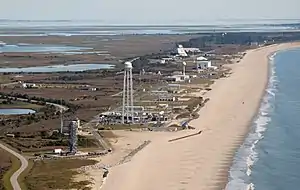 The LP-0B (left) and LP-0A (center, with the large water tower). | |||||||||||||||||||||||||||||||||||||
| Launch site | MARS (WFF) | ||||||||||||||||||||||||||||||||||||
|---|---|---|---|---|---|---|---|---|---|---|---|---|---|---|---|---|---|---|---|---|---|---|---|---|---|---|---|---|---|---|---|---|---|---|---|---|---|
| Short name | LP-0 | ||||||||||||||||||||||||||||||||||||
| Operator | NASA VCSFA | ||||||||||||||||||||||||||||||||||||
| Total launches | 31 | ||||||||||||||||||||||||||||||||||||
| Launch pad(s) | 3 | ||||||||||||||||||||||||||||||||||||
| |||||||||||||||||||||||||||||||||||||
The launch complex consists of three individual launch pads, LP-0A, LP-0B, and Launch Complex-2 (LC-2).
Launch Pads
Pad 0A
LP-0A (located at 37.833959°N 75.4878331°W) was first built for the failed Conestoga rocket program.[4] The original launch tower was subsequently demolished in September 2008.[5] A new pad facility was built from 2009-2011 for Orbital Sciences Taurus II, now renamed Antares.[6] Pad modifications for Antares included the construction of a Horizontal Integration Facility for launcher/payload mating and a wheeled transporter/erector that will roll out and erect the rocket on its launch pad about 24 hours prior to launch.[6] The first launch of Antares occurred on April 21, 2013.[7]
The pad was reinforced with pilings and features a liquid fueling facility, flame trench, and deluge system for cooling and sound suppression. The pad is capable of supporting a gross liftoff weight of 453.6 metric tons (1,000,000 lb) and can launch payloads of up to 5,035 kilograms (11,100 lb) into low Earth orbit.[8]
On October 28, 2014, an Orbital Systems Antares rocket, flying as mission Cygnus CRS Orb-3, crashed 6 seconds after takeoff and appeared to have done significant damage to the launch pad itself. On October 29, 2014, teams of investigators began examining debris at the crash site.[9] By May 2015, estimates had been revised down to around US$13 million. At that time, NASA had committed US$5 million, Virginia Commercial Space Flight Authority committed US$3 million and Orbital ATK US$3 million. Repairs were underway and planned to be completed by September 2015, but repairs were only funded up to August with Virginia CSFA requesting that Orbital provide the remaining US$2 million. On September 30, 2015, the spaceport announced repairs on pad 0A had been completed.[10] The launch pad resumed flight operations with the Cygnus CRS OA-5 mission on October 17, 2016.[11]
In March 2021, Rocket Lab announced that they would launch their upcoming medium-lift launch vehicle Neutron from LP-0A,[12] with the initial launch planned for as early as 2024.[13] However, Rocket Lab later opted to construct their own Neutron launch site south of Pad 0B.
Antares will continue flights from Pad 0A indefinitely, as Northrop Grumman transitions from the 200-series to the 300-series of the rocket. Said transition will require moderate renovations to the pad and surrounding facilities in order to support the upgrade rocket's larger first stage.[14]
Gallery
 Conestoga-1620 on pad, 1995
Conestoga-1620 on pad, 1995.jpg.webp) Antares 110 on pad (Antares A-One), 2013
Antares 110 on pad (Antares A-One), 2013.jpg.webp) Antares 120 on pad (CRS Orb-1), 2014
Antares 120 on pad (CRS Orb-1), 2014.jpg.webp) Antares 130 on pad (CRS Orb-3), 2014
Antares 130 on pad (CRS Orb-3), 2014.jpg.webp) The Pad 0A facilities the day after the October 28, 2014 launch failure.
The Pad 0A facilities the day after the October 28, 2014 launch failure..jpg.webp) Antares 230 on pad (CRS OA-8E), 2017
Antares 230 on pad (CRS OA-8E), 2017.jpg.webp) Antares 230+ on pad (Cygnus NG-12), 2019
Antares 230+ on pad (Cygnus NG-12), 2019 Pad 0A, used by Antares, is second from the near end, next to the tall water tower.
Pad 0A, used by Antares, is second from the near end, next to the tall water tower.
Launches
| Date (UTC) | Vehicle | Payload | Result | Remarks |
|---|---|---|---|---|
| 23 October 1995, 22:02 | Conestoga 1620 | Meteor recoverable experimental satellite | Failure | The only orbital launch attempt of Conestoga. |
| 21 April 2013, 21:00 | Antares 110 | Antares A-ONE | Success[15] | |
| 18 September 2013, 14:58 | Antares 110 | Cygnus Orb-D1 | Success[16] | COTS Demo Mission |
| 9 January 2014, 18:07[17][18][19] | Antares 120 | Cygnus CRS Orb-1 | Success | First Cygnus.
ISS re-supply mission. |
| 13 July 2014, 16:52[20] | Antares 120 | Cygnus CRS Orb-2 | Success | ISS re-supply mission. |
| 28 October 2014, 22:22[21] | Antares 130 | Cygnus CRS Orb-3 | Failure[22] | Pad damaged by explosion and fire. |
| 17 October 2016, 23:45 [23] | Antares 230 | Cygnus CRS OA-5 | Success | ISS re-supply mission. |
| 12 November 2017, 12:19 | Antares 230 | Cygnus CRS OA-8E | Success | ISS re-supply mission. |
| 21 May 2018, 08:44 | Antares 230 | Cygnus CRS OA-9E | Success | ISS re-supply mission. |
| 17 November 2018, 09:01 | Antares 230 | Cygnus NG-10 | Success | ISS re-supply mission. |
| 17 April 2019, 16:46 | Antares 230 | Cygnus NG-11 | Success | ISS re-supply mission. |
| 2 November 2019, 13:59 | Antares 230+ | Cygnus NG-12 | Success | ISS re-supply mission. |
| 15 February 2020, 20:21 | Antares 230+ | Cygnus NG-13 | Success | ISS re-supply mission. |
| 3 October 2020, 02:16 | Antares 230+ | Cygnus NG-14 | Success | ISS re-supply mission. |
| 20 February 2021, 17:36 | Antares 230+ | Cygnus NG-15 | Success | ISS re-supply mission. |
| 10 August 2021, 22:01 | Antares 230+ | Cygnus NG-16 | Success | ISS re-supply mission. |
| 19 February 2022, 17:40 | Antares 230+ | Cygnus NG-17 | Success | ISS re-supply mission. |
| 7 November 2022, 10:32 | Antares 230+ | Cygnus NG-18 | Success | ISS re-supply mission. |
Pad-0B
LP-0B (located at 37.8311576°N 75.4913829°W) became operational in 1999,[24] and was subsequently upgraded in 2003 with the construction of a mobile service tower, which was completed in 2004.[25] It is active, and is currently used by Northrop Grumman Minotaur rockets. The first launch from LP-0B was of a Minotaur I in December 2006,[26] and was the first launch from the Mid-Atlantic Regional Spaceport.
Pad 0B hosted the Minotaur V launch of the LADEE lunar orbiter in 2013, becoming the first (and so far only) beyond-Earth mission to launch from Wallops.
On October 19, 2017, Vector Launch announced plans to conduct three launches from near Pad 0B with its then-in-development Vector-R small satellite launch vehicle over the subsequent two years, with an option for five additional launches.[27] However, following the company's bankruptcy and restructuring, plans for these launches are unlikely.
Gallery
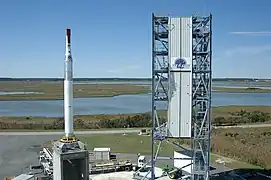 ALV X-1, 2008
ALV X-1, 2008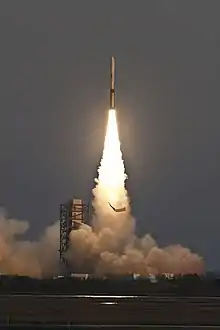 Minotaur I launch (TacSat-3), 2009
Minotaur I launch (TacSat-3), 2009 Minotaur I on pad (ORS-1), 2011
Minotaur I on pad (ORS-1), 2011.jpg.webp) Gantry at Pad 0B on Sept. 4, 2013.
Gantry at Pad 0B on Sept. 4, 2013.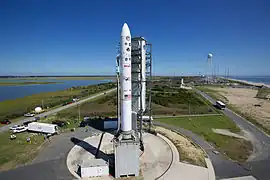 Minotaur V on pad (LADEE), 2013
Minotaur V on pad (LADEE), 2013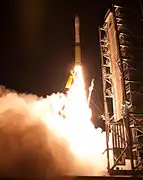 Minotaur I launch (STPSat 3), 2013
Minotaur I launch (STPSat 3), 2013
Launches
| Date (UTC) | Vehicle | Payload | Result | Remarks |
|---|---|---|---|---|
| 16 December 2006, 12:00 | Minotaur I | TacSat-2 / GeneSat-1 | Success[28] | |
| 24 April 2007, 06:48 | Minotaur I | NFIRE | Success[28] | |
| 22 August 2008, 09:10 | ALV X-1 | Hy-BoLT / SOAREX-VI | Failure[29] | Suborbital launch. |
| 19 May 2009, 23:55 | Minotaur I | TacSat-3 | Success | |
| 30 June 2011, 03:09 | Minotaur I | USAF ORS-1 Satellite | Success | |
| 7 September 2013, 03:27 | Minotaur V | LADEE mission to Lunar orbit | Success | |
| 20 November 2013, 01:15 | Minotaur I | ORS 3, STPSat-3 | Success | |
| 15 July 2020, 13:46 [30] | Minotaur IV | NROL-129 | Success | Classified NRO payload. |
| 15 June 2021, 13:35 | Minotaur I | NROL-111 | Success | Classified NRO payload. |
Launch Complex-2 (Pad 0C)
In October 2018, Rocket Lab announced that it had selected Mid-Atlantic as its second launch site (the launch site in Mahia had at the time 2 pads, so this was Rocket Lab's third launch pad) called Rocket Lab Launch Complex-2 (LC-2) or Launch Pad 0C (located at 37.833266°N 75.4882304°W). The new launch pad is near Pad 0A (and shares some systems with Pad 0A).[31][32][33][34] Rockets launched from LC-2 are integrated at Rocket Lab's integration facility, located just a few miles away from the pad. They are transported to the pad and integrated onto the strongback.[35]
In December 2019, construction was completed and Rocket Lab inaugurated Launch Complex 2 at Mid-Atlantic Regional Spaceport.[31] In April 2020, Rocket Lab performed a Wet Dress Rehearsal with an Electron rocket on the pad.[33]
The first launch from LC-2 successfully occurred on January 24, 2023. An Electron rocket carried three satellites to orbit in a mission named "Virginia is for Launch Lovers".[36][1][37]
Launches
| Date (UTC) | Vehicle | Payload | Result | Remarks |
|---|---|---|---|---|
| 24 January 2023, 23:00 | Electron | HawkEye 360 Cluster 6 | Success | First launch from Rocket Lab Launch Complex-2.[38] |
| 16 March 2023, 22:39 | Electron | Capella 9, 10 | Success | |
| 18 June 2023, 01:25 | Electron | HASTE: DYNAMO-A | Success | First launch of the HASTE program; suborbital trajectory |
Launch statistics
- Antares (0A)
- Minotaur I (0B)
- Minotaur IV (0B)
- Minotaur V (0B)
- Electron (2)
Chart excludes the only launch of Conestoga from pad 0A in 1995; the launch attempted to put a satellite into orbit but was unsuccessful. Chart also excludes the suborbital launch of ALV X-1 on 22 August 2008 from pad 0B.
References
- Harwood, William (2023-01-24). "Rocket Lab launches 3 satellites in first mission from U.S. soil". CBS News. Retrieved 2023-01-25.
- "Commercial Space Transportation License LSO-02-007" (PDF). FAA. Retrieved 23 April 2013.
- "Facility Access Plan" (PDF). Mid-Atlantic Regional Spaceport (MARS). p. 1.2.2. Archived from the original (PDF) on 3 December 2013. Retrieved 24 April 2013.
- Wade, Mark. "Wallops Island LA0A". Encyclopedia Astronautica. Archived from the original on 2008-11-20. Retrieved 2009-01-21.
- "Launch Tower Demolition". GMB. Retrieved 2009-01-21.
- Kyle, Ed (2011-05-14). "TaConurus 2". Space Launch Report. Retrieved 2011-12-19.
- "NASA Partner Orbital Sciences Test Launches Antares Rocket". NASA. Retrieved 21 April 2013.
 This article incorporates text from this source, which is in the public domain.
This article incorporates text from this source, which is in the public domain. - "MARS Launch Pad 0A" (PDF). Orbital Sciences.
- "Teams investigate failure of unmanned rocket off Virginia coast". cnn.com. 29 October 2014. Retrieved 29 October 2014.
- "Completion Of Repairs at the Mid-Atlantic Regional Spaceport Launch Pad 0A". vaspace.org. September 30, 2015.
- Graham, William (17 October 2016). "Antares 230 successfully returns with launch of OA-5 Cygnus". nasaspaceflight.com. Retrieved 3 August 2017.
- Foust, Jeff (2 March 2021). "Rocket Lab says SPAC deal will accelerate development of Neutron rocket". SpaceNews. Retrieved 4 March 2021.
- Foust, Jeff (1 March 2021). "Rocket Lab to go public through SPAC merger and develop medium-lift rocket". SpaceNews. Retrieved 1 March 2021.
- Navin, Joseph (November 7, 2022). "SS Sally Ride Cygnus arrives at ISS on NG-18 mission". NASASpaceflight. Retrieved January 31, 2023.
- "Antares Maiden Soar Pierces Virginia Sky and delivers NASA SmartPhone Pioneer Nanosats to Orbit - Universe Today". 24 April 2013. Retrieved 12 September 2018.
- Dietrich, Tamara (19 September 2013). "Cargo ship takes off for station". Daily Press. Newport News, Virginia. p. A4. Archived from the original on 18 April 2022. Retrieved 18 April 2022 – via Newspapers.com.
- "ORB-1: Antares successfully launches Cygnus en route to ISS – NASASpaceFlight.com". www.nasaspaceflight.com. Retrieved 12 September 2018.
- "Northrop Grumman Corporation". Northrop Grumman. Retrieved 12 September 2018.
- "NASA - NSSDCA - Spacecraft - Details". nssdc.gsfc.nasa.gov. Retrieved 28 October 2020.
- Beutel, Allard (3 April 2015). "NASA Cargo Launches to Station Aboard Orbital Resupply Mission". Retrieved 12 September 2018.
- "Antares Launch Postponed to Oct. 28 – Orbital ATK". blogs.nasa.gov. Archived from the original on 25 April 2015. Retrieved 12 September 2018.
- "Teams investigate failure of unmanned rocket off Virginia coast". CNN.
- Beutel, Allard (17 October 2016). "Orbital ATK Launches NASA Resupply Mission to Space Station". Retrieved 12 September 2018.
- "Facilities". Mid-Atlantic Regional Spaceport. Archived from the original on October 16, 2008. Retrieved 2009-01-21.
- "Launch Pad 0-B" (PDF). Mid-Atlantic Regional Spaceport. Archived from the original (PDF) on July 4, 2008. Retrieved 2009-01-21.
- Wade, Mark. "Wallops Island LA0B". Encyclopedia Astronautica. Archived from the original on 2011-11-15. Retrieved 2009-01-21.
- "Vector to perform first orbital launches from Virginia". SpaceNews. 24 October 2017. Retrieved 1 March 2021.
- Wade, Mark. "Wallops Island LA0B". Encyclopedia Astronautica. Archived from the original on 2011-11-15. Retrieved 2011-12-19.
- Tennant, Diane (22 Aug 2008). "NASA destroys rocket shortly after launch at Wallops Island". Virginian-Pilot. Retrieved 2 November 2014.
- Koehler, Keith (15 July 2020). "Minotaur IV Launches from Wallops". Archived from the original on 18 April 2022. Retrieved 15 July 2020.
- Foust, Jeff (12 December 2019). "Rocket Lab inaugurates U.S. launch site". SpaceNews. Retrieved 12 December 2019.
- "Rocket Lab | News". Rocket Lab. Retrieved 2019-09-18.
- "Rocket Lab tests Electron on new Virginia launch pad". SpaceNews.com. 2020-04-30. Retrieved 2020-05-24.
- "Virginia Space on Twitter". 6 December 2022. Retrieved 8 December 2022.
- "Rocket Lab | Our Launch Sites". Rocket Lab. Retrieved 2018-12-30.
- "Rocket Lab conducts first Electron launch from American soil". NASASpaceflight. Retrieved 2023-01-24.
- "Virginia is for Launch Lovers". Rocket Lab. Retrieved 2023-06-18.
- Harwood, William (2023-01-24). "Rocket Lab launches 3 satellites in first mission from U.S. soil". CBS News. Retrieved 2023-01-25.